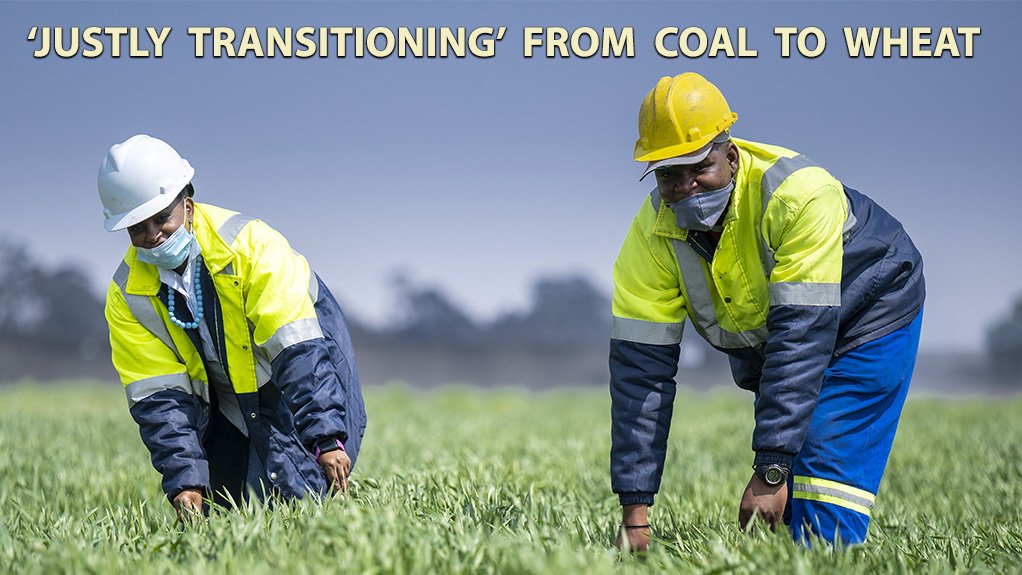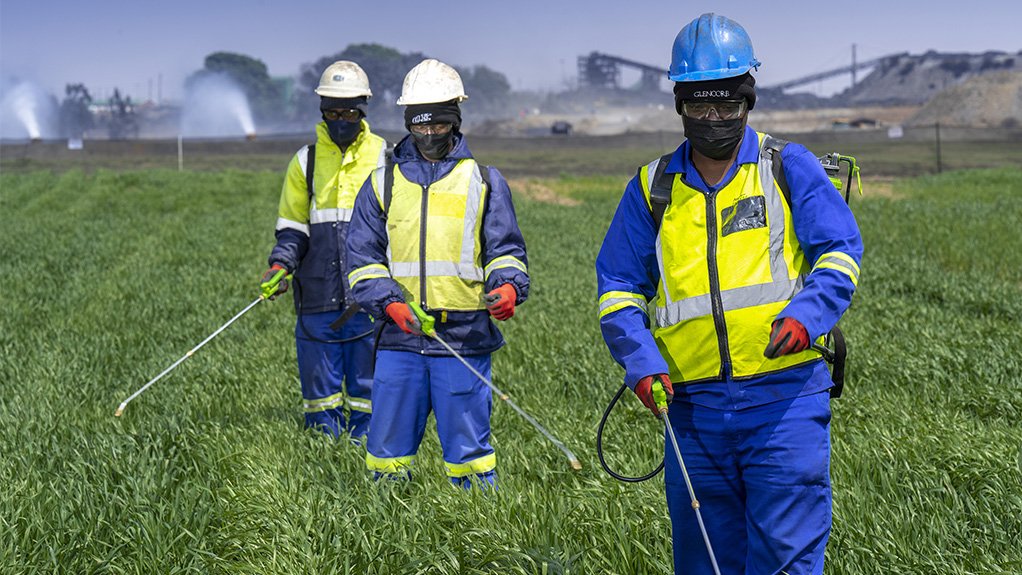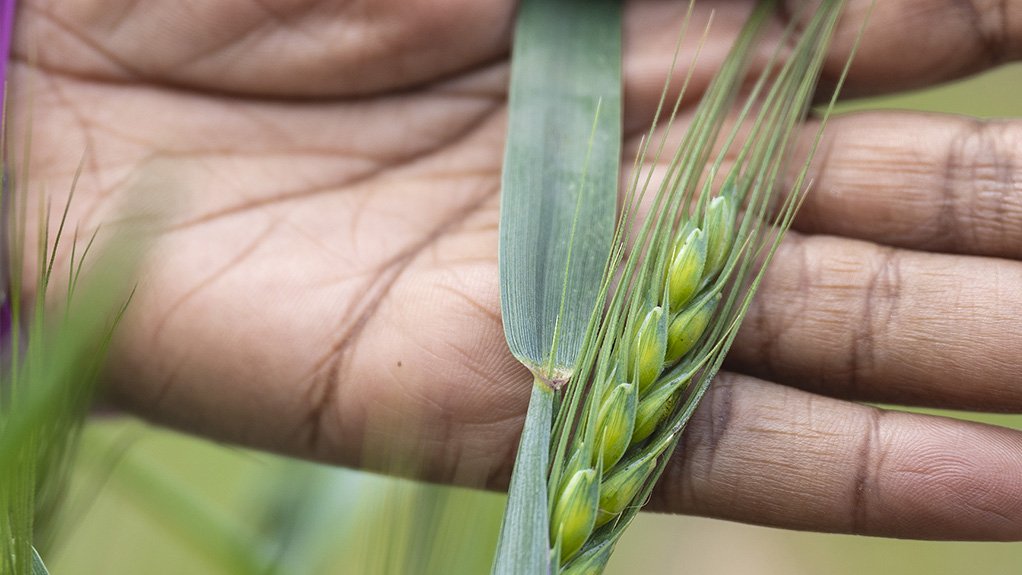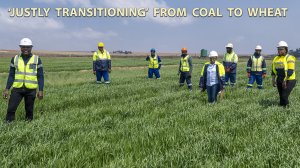Glencore sets ‘just transition’ from coal in promising motion with wheat pilot project




Glencore ‘just transition’ pilot project explained to Mining Weekly’s Martin Creamer. Video: Darlene Creamer.
Glencore sets 'just transition' in motion with winter wheat growing at Umsimbithi’s Wonderfontein colliery, Mpumalanga.
Glencore sets 'just transition' in motion with winter wheat growing at Umsimbithi’s Wonderfontein colliery, Mpumalanga.
Winter wheat growing at Umsimbithi’s Wonderfontein colliery, Mpumalanga.
Glencore has set the ‘just transition’ in promising motion with a highly successful winter wheat pilot project in Mpumalanga, South Africa’s province of coal mining and coal-fired power generation.
The programme, which began in April, has been described as being hugely successful in demonstrating the value of the combination of remediated coal-mine land, mine water and agriculture.
A panel of seven, in a Zoom interview with Engineering News & Mining Weekly in late November, illustrated the sort of far-reaching work that needs to be done to limit negative impacts and maximise opportunities for local communities living within the region.
Taking part on the Zoom interview were Business for Development (B4D) director Africa operations John Cook, International Council for Mining and Metals (ICMM) environmental stewardship manager Dawn Brock, Mpumalanga Mine Water Coordinating Body programme manager Carla Hudson, Glencore environmental manager (defunct and decommissioned collieries) Kubashni Mari, B4D CEO Karen James, Glencore agronomy and field operations manager Chiedza Sibanda, and Glencore environmental and long-term water group manager Nico Dooge.
The idea behind this programme, based at Umsimbithi’s Wonderfontein colliery, came from a workshop involving the Mine Water Coordinating Body, Glencore and Anglo American, at the start of 2020.
It determined that there was an opportunity in Mpumalanga to look at mining assets and the benefit they may potentially have for community agriculture.
On the basis of strong support from the ICMM, Glencore, Anglo American and the Mine Water Coordinating Body, B4D spent some time thinking about how it might be able to instigate a programme to see whether mine water and remediated land could contribute to community agriculture – and hopefully provide the basis of future industries for the community that in time might replace the employment and incomes being earned from coal-fired power generation and coal mining.
Winter wheat was specifically targeted because a cereal company in South Africa felt that the grain could potentially be of use in the manufacture of its cereals, while underlining the currently pervasive environment, social and governance (ESG) principles adopted by mining companies.
Go-ahead followed Glencore, Mpumalanga’s Mining Water Coordinating Body, the ICMM and Anglo American demonstrating a willingness to explore the outcome of mining assets underpinning agriculture.
Research is being completed to ensure that there are no inadvertent residuals coming from either the water or the remediated land that would be injurious to using the grain grown for food consumption.
The programme is now on the brink of being a very successful demonstration of ‘just transitioning’ from coal to agriculture, with renewable energy and potential value addition spin-offs creating considerable enthusiasm.
Engineering News & Mining Weekly: What important benefits can regenerative uses of coal land provide to regional economies and in the avoidance of ghost towns. Does a programme like this help?
Cook: In my view it does because ultimately the business of agriculture is that more often than not what is being grown becomes the basis of happy people with food security. If you pick your crops properly, you then have the opportunity to supply product into industrial markets and when you think about the volume of grain used by cereal companies, that can generate very substantial amounts of activity for farmers and also create the ability to get into value addition by processing the grains, by milling and potentially making products from the grains. So, we’re starting with, I guess, growing agriculture and then building the scale of those operations to the point when you can then in that community start investing in the processing equipment to make it more meaningful. So, the answer to that is an emphatic yes. You start small and with success such as we’ve been experiencing, there is every reason to suspect that we could be building strong vibrant industries well into the future, based on bringing smallholder farmers into a solid knowledge of how to succeed with their agriculture, giving them access to the markets they need and the relationships that they require to scale up and effectively emerge with a very large industry on the back of a very small start.
Why was Umsimbithi’s Wonderfontein colliery selected and what about other opportunities, given its success?
Cook: At the end of the day, a wonderful person was approached by Carla to consider becoming involved in the programme. Nico, too, has proven to be a wonderful advocate of our programme and a fearless supporter with his management and brought the idea to them late last year and they quickly fell in behind what he felt this programme could offer, and Glencore have proven to be wonderful sponsors of our programme since we commenced in April.
Cook: I’m very sure that Glencore senior management probably recognise that their skills are with mining but, like so many fine companies, they’ve recognised that they have a responsibility to the community and they probably see that remediated land and mine water do represent valuable inputs to agriculture so I’m sure they’re probably going to be leaving agriculture to the experts and that will be the commercial operators and the smallholder farmers, and they probably also recognise that if they could assist, that they have a responsibility towards those farmers and community generally to do so.
On the global front, are there many regenerative uses for coal land being planned around the coal world?
Brock: One thing that we are seeing globally, especially coming out of COP26 – we’ve already heard from South African President Cyril Ramaphosa that South Africa is going to be starting this ‘transition’ towards renewable energies et cetera, and we have already been seeing this in areas such as Europe and also more recently probably in China and the US, where there was a huge reliance in terms of coal energy – and obviously given mechanisms and mining are changing, is that new government policies are coming out. We’ve seen commitments towards renewable energy. This is requiring now a substantial shift in the ways that areas are operating and it requires quite a big process. We’ve seen the likes of the World Bank that have undertaken a number of studies to see what the lessons learnt from some of these regions have been in terms of transitioning to renewable energies and there’s been quite substantial impact in terms of job losses and communities within those areas being left without livelihoods.
We’re looking at renewable energy, agriculture and mentioned too was water. Should abandoned mines not also be considered as sites where the water in those mines can also be used to generate electricity?
Hudson: There has been work done to specifically look at that but mostly the decision has been made that, as South Africa is a relatively dry country and needs to look at food security and job creation, the preference was to look at how the affected mine water can actually be used in socioeconomic upliftment projects, while ensuring water security and food security.
If I came back to you in five years, what do you expect to be available here, what is the vision, given the infinite horizons of agriculture and renewable energy?
Hudson: Through The Impact Catalyst, we’re working very closely with the Mpumalanga provincial government’s Department of Economic Development and Tourism. We had a visioning session in August where we discussed what we would like to see in this area in 2040, and the need to start planning on that vision now. We have realised that the communication between the public and private sectors is very important and that alignment is happening. The thinking of how we’re going to move from coal-generated power to new power has been in our minds since 2015. There has been a look at how we change national perception on financial provision for mine closure, focus on how we deal with this in a very collaborative, sustainable way. We’re looking at all aspects, not just agriculture. We’re looking at how we can expand information and communication technology networks and ensure that health and sanitation form part of the process because of the need for a healthy and well-educated population to perform the jobs that will be created. We’re looking at this wonderful new term called the ‘circular green economy’ where we make sure that the waste that is currently there is used productively and becomes an asset, as well as how agriculture can form part of the renewable energy.
James: Vision is one of my favourite topics. Vision happens when you’re clear on your purpose. It’s really your purpose realised, and when we came together two years ago in September, I was in South Africa and I met Nico and Carla and Dawn and I worked together, and it was about reusing assets and leveraging that to enable a different outcome. That was the whole purpose of the workshop – how do we bring these things to life? Post COP26, it’s very clear that this has to happen and it has to happen with urgency. This will take us to the future and this co-work is operating with urgent optimism. I don’t know the figures around the world but I know in Australia there are 60 000 abandoned mines in Australia alone. Just in one region of Western Australia, there are 341 000 acres of land sitting there. So the vision is to do exactly what Carla said but then to take this and potentially blueprint the idea so that it can be used elsewhere, in other regions of South Africa, in other regions of Africa and potentially in Australia and around the world.
Mari: You mentioned early on about the concept of ghost towns and that’s one of the things that we know has happened especially in the gold mining sector when mining shuts down and then we’re left with ghost towns because more often than not it’s the mining industry that takes on the responsibility of what government should be providing for in terms of services. The way we see it at Glencore as well is that mining should be the catalyst that actually spurs on all these other activities, be they economic or social development. When Glencore is no longer there, what we leave behind is our legacy, so that’s what we’re aiming for with this pilot. It’s quite small currently but in terms of vision, we hope to expand. We’ve been working closely with all our partners, The Impact Catalyst and B4D. We’re assisting with on-the-ground execution of this project, not only providing the land, but providing our input where we can assist to make this project a success.
Brock: Just to provide a global perspective, we’re expecting a number of planned mine closures to be carried out in the next 10 to 20 years and probably one thing that we’ve seen from this partnership is that this is something that you can’t do alone in many cases and sustainable mine closure requires collaboration between industry, communities and government to understand and address the environmental, social and economic aspects of closure, and this needs to be undertaken early on so that these stakeholders can be brought on board so that we can have a sound basis for the management of these areas, because obviously there’s going to be many livelihoods and communities that are likely to be impacted by this if not done properly.
James: The Nelson Mandela quote that Mine Water Coordinating Body chose to begin the annual general meeting was highly appropriate, namely that a vision without action is just a dream, action without vision just passes the time but vision with action can change the world.
Comments
Press Office
Announcements
What's On
Subscribe to improve your user experience...
Option 1 (equivalent of R125 a month):
Receive a weekly copy of Creamer Media's Engineering News & Mining Weekly magazine
(print copy for those in South Africa and e-magazine for those outside of South Africa)
Receive daily email newsletters
Access to full search results
Access archive of magazine back copies
Access to Projects in Progress
Access to ONE Research Report of your choice in PDF format
Option 2 (equivalent of R375 a month):
All benefits from Option 1
PLUS
Access to Creamer Media's Research Channel Africa for ALL Research Reports, in PDF format, on various industrial and mining sectors
including Electricity; Water; Energy Transition; Hydrogen; Roads, Rail and Ports; Coal; Gold; Platinum; Battery Metals; etc.
Already a subscriber?
Forgotten your password?
Receive weekly copy of Creamer Media's Engineering News & Mining Weekly magazine (print copy for those in South Africa and e-magazine for those outside of South Africa)
➕
Recieve daily email newsletters
➕
Access to full search results
➕
Access archive of magazine back copies
➕
Access to Projects in Progress
➕
Access to ONE Research Report of your choice in PDF format
RESEARCH CHANNEL AFRICA
R4500 (equivalent of R375 a month)
SUBSCRIBEAll benefits from Option 1
➕
Access to Creamer Media's Research Channel Africa for ALL Research Reports on various industrial and mining sectors, in PDF format, including on:
Electricity
➕
Water
➕
Energy Transition
➕
Hydrogen
➕
Roads, Rail and Ports
➕
Coal
➕
Gold
➕
Platinum
➕
Battery Metals
➕
etc.
Receive all benefits from Option 1 or Option 2 delivered to numerous people at your company
➕
Multiple User names and Passwords for simultaneous log-ins
➕
Intranet integration access to all in your organisation





















